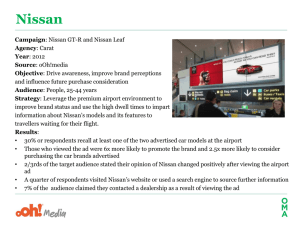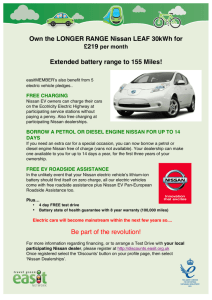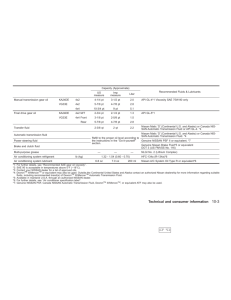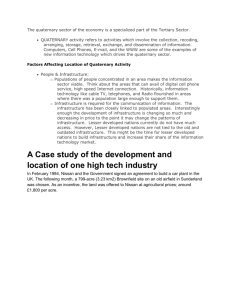Company Profile. Nissan Motor Co., Ltd.
advertisement
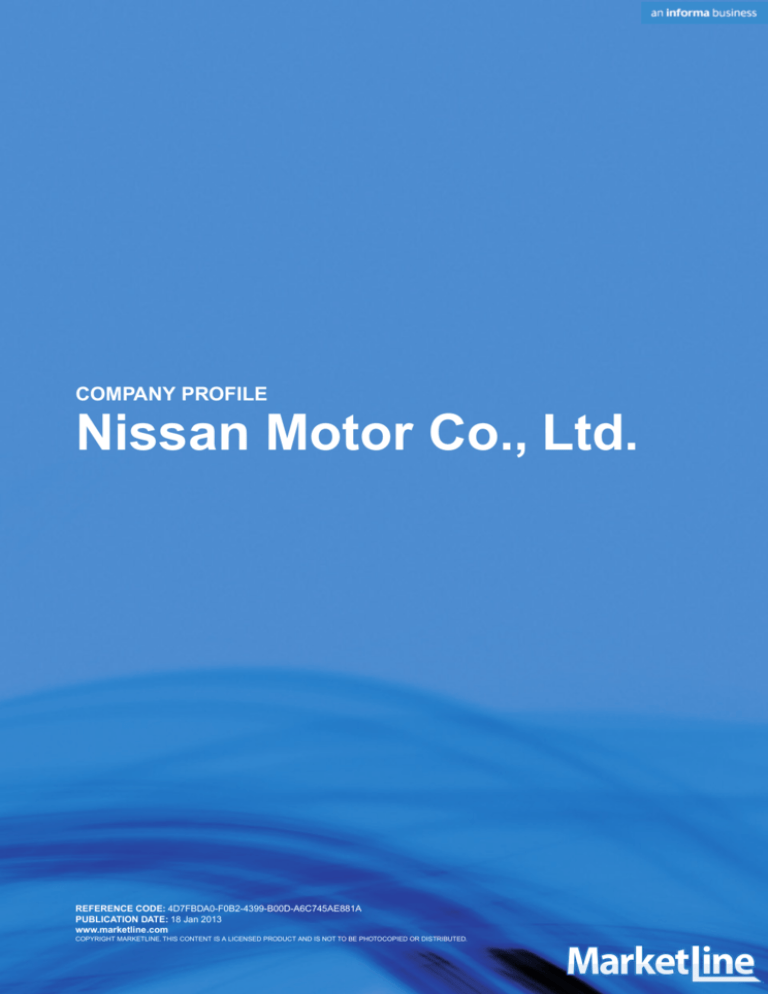
COMPANY PROFILE Nissan Motor Co., Ltd. REFERENCE CODE: 4D7FBDA0-F0B2-4399-B00D-A6C745AE881A PUBLICATION DATE: 18 Jan 2013 www.marketline.com COPYRIGHT MARKETLINE. THIS CONTENT IS A LICENSED PRODUCT AND IS NOT TO BE PHOTOCOPIED OR DISTRIBUTED. Nissan Motor Co., Ltd. TABLE OF CONTENTS TABLE OF CONTENTS Company Overview..............................................................................................3 Key Facts...............................................................................................................3 SWOT Analysis.....................................................................................................4 Nissan Motor Co., Ltd. © MarketLine Page 2 Nissan Motor Co., Ltd. Company Overview COMPANY OVERVIEW Nissan Motor Co., Ltd. (Nissan or “the group”) is engaged in the planning, developing, manufacturing, and marketing of passenger automobiles, automobile parts, marine equipment and forklifts. The group has significant operations in Japan, North America, and Europe. It is headquartered in Kanagawa, Japan and employed 157,365 people as of March 31, 2012. The group recorded revenues of JPY9,409,026 million ($119,212.4 million) during the financial year ended March 2012 (FY2012), an increase of 7.2% over FY2011. The operating profit of the group was JPY545,839 million ($6,915.8 million) in FY2012, an increase of 1.6% over FY2011. Its net profit was JPY341,433 million ($4,326 million) in FY2012, an increase of 7% over FY2011. KEY FACTS Head Office Nissan Motor Co., Ltd. 1-1 Takashima 1-chome Nishi-ku Yokohama-shi Kanagawa 220 8686 JPN Phone 81 45 523 5523 Fax 81 45 523 5770 Web Address http://www.nissan-global.com Revenue / turnover 9,409,026.0 (JPY Mn) Financial Year End March Employees 157,365 Tokyo Ticker 7201 OTC Bulletin Board NSANY Market Ticker Nissan Motor Co., Ltd. © MarketLine Page 3 Nissan Motor Co., Ltd. SWOT Analysis SWOT ANALYSIS Nissan is engaged in the planning, developing, manufacturing, and marketing of passenger automobiles, automobile parts, marine equipment and forklifts. Nissan has strong research and development (R&D) capabilities, which enable the group to build a broad range of vehicle portfolio with innovative technologies that enhances its competitive strength. However, increased competition may lead to lower vehicle unit sales and increased inventory, which may create pricing pressure on the group and adversely influence the group's financial condition and results of operations. Strengths Weaknesses Robust research and development activities Fairly spread product portfolio Diverse geographic presence Strong financial performance Declining brand image due to product recalls Opportunities Threats Reintroduction of the Datsun brand Strong outlook for the global new car market Strong focus on zero-emission technologies Competition in the global automotive market Appreciating Japanese Yen a major concern Stringent environment regulations could increase production costs Strengths Robust research and development activities Nissan has strong research and development (R&D) capabilities. It spends considerable amount of its sales for R&D activities. For instance, the total R&D costs of the group stood at JPY428,018 million ($5,422.9 million) in FY2012, an increase of 7.2% compared to FY2011. The R&D expenditure stood at 4.5% of the total revenues in FY2012. The group's R&D activities focus on the environment, vehicle safety, information technology, and product development. In the recent years, the group has come up with innovative product across the categories like electric vehicles and fuel cell hybrid technologies. For instance, Nissan unveiled Nissan LEAF in 2009 and started commercial sales in 2010. The LEAF with sales of 28,000 is the largest player in the global EV category. In addition, Nissan plans to launch three more EV models by FY2016. The group has already launched the e-NV200 light commercial van concept and the Infiniti LE luxury sedan. In 2011, the group released the new LEAF to Home power supply system, which enables car users to supply electricity from EVs to their houses. Nissan Motor Co., Ltd. © MarketLine Page 4 Nissan Motor Co., Ltd. SWOT Analysis In addition, the group also introduced many new technologies. For instance, the group is in the process of developing a new hybrid system for front-wheel drive vehicles, which uses one-motor, two-clutch hybrid system. The final product is expected to be commercially launched in 2013. The group also focuses on the development of light materials to increase fuel efficiency and was the first to release the 1.2 gigapascals (Gpa) class, high-formability, high tensile strength steel (for cold press). Its onboard adoption for global distribution is scheduled in 2013. Thus, strong R&D capability enables the group to build a broad range of vehicle portfolio with innovative technologies that enhances its competitive strength. Fairly spread product portfolio Although the group is principally an automobile manufacturer, its product portfolio is fairly spread. The group is engaged in the manufacturing and sale forklifts, marine products and related parts, apart from automobiles. The vehicle division manufactures passenger cars, zero emission vehicles, compacts, sedans, sports utility vehicles (SUVs), minivans, wagons, crossovers, pickups, and light commercial vehicles. The group markets its passenger cars under Nissan and Infiniti brand names. Some of the key brands of the group include Leaf, Micra, Cube, Sunny, Tsuru, Versa, Bluebird, Fairlady, GT-R, Wingroad, Sentra, Lafesta, Juke, Rogue, Altima, Maxima, X-trail, Patrol, Pathfinder, Armada, Xterra, Murano, Quest, Elgrand, Livina, Serena, Clipper, Frontier, Titan, Altas, Primaster, and Teana. Nissan manufactures luxury cars under the brand name Infiniti. Infiniti offers its vehicles across the globe. Some of its models include Infiniti G, G Coupe, G Convertible, M, EX, JX, FX and QX. The group plans to re-launch the Datsun branded automobiles in Indonesia, India and Russia from 2014. Moreover, the group’s forklift business supports the logistic operation of various industries by providing forklifts and other material handling equipment with a worldwide sales/service network spanning over 85 countries. The group also offers marine products, including outboards. Nissan outboards, parts and service are available through over 850 marine dealerships throughout North America. Hence, the group’s fairly spread product portfolio reduces business risks and provides a platform for future growth. Diverse geographic presence The group has a wide geographic base. The group manufactures vehicles in 20 countries and offers its products and services in more than 160 countries worldwide. Due to geographical complementarities, Renault and Nissan cover key markets in all continents. Renault's historical territories are Europe, North Africa, and South America; Nissan's major markets are Japan, North America, Mexico, China, and the Middle East. Since 2005, Renault and Nissan have been entering new territories together, such as India, in order to expand their global footprint. Nissan has operations across Japan, North America, Asia, Europe and other foreign countries. In addition, the group is well diversified in terms of revenue generation from these regions. For instance, in FY2012, the group generated 23.7 of its total revenues from Japan, 33.6% from North America, 18.9% from Asia, 16.3% from Europe, and 7.5% from other foreign countries. Thus, the global Nissan Motor Co., Ltd. © MarketLine Page 5 Nissan Motor Co., Ltd. SWOT Analysis operations not only provide protection against unfavorable forces in specific market but also enable the group to benefit from opportunities available in both mature and emerging markets. Strong financial performance The group has witnessed consistent strong financial performance over the past few years. For instance, the group's revenues increased to JPY9,409,026 million ($119,212.4 million) in FY2012 from JPY7,517,277 million ($95,243.8million) in FY2010, representing a compound annual growth rate (CAGR) of 11.9%. In addition, the group's operating and net income also witnessed positive growth during the period. The group's operating income grew at a CAGR of 32.4%, while the net income almost trebled to JPY341,433 million ($4,325.9 million) in FY2012 from JPY42,390 million ($537 million) in FY2010. Moreover, in FY2012, the group’s revenues grew 7.2%, while the operating and net income grew by 1.6% and 7%, respectively to JPY545,839 million ($6,915.8 million) and JPY341,433 million ($4,326 million) in FY2012. The group also witnessed strong growth across all geographies. In FY2012, revenue from Japan grew by 5.3%, while the North America, Asia and Europe grew by 2.5%, 11.2% and 16.8%, respectively. Revenues from other foreign countries grew by 7.2% in FY2012. Thus, strong financial performance of the group improves the operational efficiency and market position apart from helping the growth initiatives of the group. Weaknesses Declining brand image due to product recalls The group has issued a number of product recalls in the recent past. For instance, in October 2012, Nissan recalled 13,919 Altima sedans built between May and July 2012, as they may have been equipped with transverse link bolts and power steering rack bolts that were not torqued to proper specification. Similarly in September 2012, Nissan recalled 2012 Frontier, Pathfinder, and Xterra two-wheel drive vehicles manufactured between June 2012 and July 2012, as these vehicles may have been equipped with front wheel hubs that may not meet the design hardness specifications. Also in May 2012, Nissan recalled 2012 Juke vehicles manufactured between February 2012 and May 2012, due to an incomplete weld penetration, the rear seat back striker may partially separate in a crash. Earlier in 2011, Nissan recalled nearly 34,000 Sentra compact cars because of a battery cable problem that could cause the engines to stall. Documents filed with the National Highway Traffic Safety Administration (NHTSA) reveals that cars can stall while moving and it may not be possible to restart them, increasing the risk of a crash.The problem impacts 2010 and 2011 Sentras equipped with MR-20 engines that were built in 2010. Further in the year, Nissan recalled more than 28,000 Juke small crossover SUVs from the 2011 model year. In addition, Nissan planned to recall 118,000 Jukes worldwide after discovering instances of faulty door locks and turbochargers. Significant Nissan Motor Co., Ltd. © MarketLine Page 6 Nissan Motor Co., Ltd. SWOT Analysis product recalls like these indicate poor quality checks of vehicles by the group, which in turn negatively impact’s consumer confidence in Nissan's products and also hamper’s its brand image. Opportunities Reintroduction of the Datsun brand The group has announced plans to re-launch the Datsun brand as part of its strategy to enter the ultra-low cost cars segment. As part of this strategy, the group will sell Datsun-branded vehicles in Indonesia, India and Russia from 2014. The group plans to sell Datsun-branded vehicles in Indonesia at a price range of below $10,000 and in India in a price range of below $4,000. Moreover, in Russia, the group has forged a $750-million joint venture deal for control of Russian car maker AvtoVAZ. The group will share capacity at its factory at Togliatti, Russia to build cars for all its brands, including Nissan’s Almera and Datsun. The group believes that by introducing a new ultra cheap car brand, it can penetrate markets in these three high growth markets. The ultra-low cost cars segment holds a market share of approximately 43% in India and Russia. Similarly in the Indonesian market, the ultra-cheap car market is expected to hold a 43% market share in the coming years. Currently, the group has no offerings for this segment in any of the three markets. The introduction of the Datsun brand in the ultra-cheap car segment thus provides a growth opportunity for the group in these three high growth markets. Strong outlook for the global new car market The global new cars market has experienced moderate growth during 2008-2012. However, forecasts suggest this will accelerate to strong double digit growth during the 2012-2016 periods. According to MarketLine (a unit of Informa plc), the global new cars market generated total revenues of $1,426.6 billion in 2012, representing a growth of 9.2% compared to 2011. The performance of the segment is forecast to accelerate, with an anticipated CAGR of 10.8% for the four-year period 2012-16, which is expected to drive the industry to a value of $2,153.2 billion by the end of 2016. Nissan is one of the leading automobile companies in the world offering new models every year to boost sales. In FY2012, the group launched a number of new cars, including the fully redesigned Caravan, the VENUCIA R50 car, the new Serena S-HYBRID in Japan. The group also launched the global compact sedan Nissan Latio in Japan and the sedan Nissan Sylphy and NV350 Caravan Wide Body in Japan. Moreover, in January 2013, Nissan introduced the Juke Nismo, a high-performance sports vehicle at the 2013 Tokyo Auto Salon. Thus, the strong outlook for the global new car market coupled with the group’s new product launches provides a growth opportunity for the group. Strong focus on zero-emission technologies Nissan Motor Co., Ltd. © MarketLine Page 7 Nissan Motor Co., Ltd. SWOT Analysis The group has been focusing on zero-emission technologies to address the increasing demand for eco-friendly cars due to the rising concerns on environment and increased emissions regulations. The rising energy costs and increased emissions regulations are likely to increase the demand for hybrid electric vehicles (HEVs), as hybrid engines are more fuel efficient and less polluting than conventional gasoline and diesel engines. Cost disparities between HEVs and conventional light vehicles are expected to decline as production volumes increase. According to industry estimates, electric vehicles globally are expected to grow at a CAGR of 6%. Also hybrid cars, which include plug-in hybrid and electric battery, are projected to grow at a CAGR of 39% for the 2012- 2020 periods. It is further projected that, the primary markets for HEVs will be within the Japan, the US and Western Europe. The rapidly growing Chinese and Indian market is also expected to experience relatively strong demand for these fuel efficient and environmentally friendly vehicles. The group is one of the leading players in the zero-emission technologies. The Renault Nissan alliance has signed more than 60 agreements worldwide aimed at preparing markets and infrastructures for the mass market launch of electric vehicles. Nissan’s electric vehicle (EV) lineup will include a light commercial vehicle and an all-electric premium car, to be launched by Infiniti in the near future. As part of this strategy, Nissan launched the all-new 100% electric, zero-emission Nissan LEAF in Japan, in 2010. In May 2012, Nissan and Nichicon announced plans to launch the LEAF to Home power supply system, which can supply electricity from batteries onboard the Nissan LEAF electric vehicles to homes when used with the EV Power Station unit developed by Nichicon. The group plans to sell 1.5 million EVs worldwide by 2016. Thus, investments in zero-emission technologies would enable the group to diversify its product portfolio and also help Nissan to further improve its brand image globally. Threats Competition in the global automotive market The worldwide automotive market is highly competitive. Nissan faces strong competition from other automotive manufacturers such as Toyota Motor, Honda Motor, Suzuki, General Motors, Volkswagen, and Ford among others. The competition among various auto players is likely to intensify in light of continuing globalization and consolidation in the worldwide automotive industry. The factors majorly impacting competition include product quality and features, the amount of time required for innovation and development, pricing, reliability, safety, fuel economy, customer service, and financing terms. Increased competition may lead to lower vehicle unit sales and increased inventory, which may create pricing pressure on the group and adversely influence its financial condition and results of operations. Appreciating Japanese Yen a major concern Nissan is sensitive to the fluctuations in foreign currency exchange rates and is principally exposed to fluctuations in the value of the Japanese Yen, the US dollar and the Euro. The group manufactures vehicles in 20 countries and offers its products and services in more than 160 countries worldwide. Its procurement activities for raw materials, parts/components and services are conducted in many Nissan Motor Co., Ltd. © MarketLine Page 8 Nissan Motor Co., Ltd. SWOT Analysis countries. As the consolidated financial statements of the group are calculated and presented in Japanese yen, the appreciation of the yen against other currencies adversely affects the group’s financial results of operations, in general. Any sharp appreciation of the currencies of countries where the group manufactures vehicles could lead to increases in production costs that would adversely affect the group’s competitiveness. The strengthening of the Japanese Yen against the US Dollar can thus have a material adverse influence on Nissan's reported operating results, which may in turn impact the valuation of the group. Stringent environment regulations could increase production costs Nissan is subject to laws in various jurisdictions regulating the levels of pollutants generated by its plants. In addition, Nissan is subject to regulations relating to the emission levels, fuel economy, noise and safety of its products. The Air Pollution Control Law of Japan and the Road Vehicle Law and the Law Concerning Special Measures for Total Emission Reduction of Nitrogen Oxides from Automobiles in Specified Areas regulate vehicle emissions in Japan. Similarly, in the US, the federal Clean Air Act directs the Environmental Protection Agency (EPA) to establish and enforce air quality standards, including emission control standards on passenger cars, light trucks and heavy-duty vehicles. In 2007, EPA regulations that restrict emissions from passenger cars and light trucks operating at cold temperatures became effective. The new emissions standards set by these regulations are being phased in between 2010 and 2013. Similar standards that further restrict emissions from heavy-duty vehicles operating at cold temperatures are expected to be phased in from 2012 to 2015. Furthermore, these emission regulations are periodically updated. For instance, in 2010, the EPA and the NHTSA issued a joint final rule to reduce the emission of greenhouse gases from passenger cars, light-duty trucks and medium-duty passenger vehicles for model years 2012 through 2016. In addition, in 2011, the EPA and the NHTSA issued a joint proposed rule to further reduce greenhouse gas emissions and improve fuel economy for passenger vehicles, light-duty trucks and medium-duty passenger vehicles for model years 2017 through 2025. In the proposed rule, these vehicles would be required to meet an estimated combined average emission level of 163 grams of carbon dioxide per mile in model year 2025, equivalent to 54.5 miles per gallon if these requirements were met through improvements in fuel economy standards. At the same time, the NHTSA also issued proposed CAFE standards for passenger vehicles and light trucks that would require manufacturers to meet an estimated combined average fuel economy level of 49.6 miles per gallon in model year 2025. The two agencies are expected to release a joint final rule in 2012. The emission standards adopted across various regions can result in additional costs for product development, testing and manufacturing operations of Nissan, which could affect the operating margins of the group. Nissan Motor Co., Ltd. © MarketLine Page 9 Copyright of Nissan Motor Co., Ltd. SWOT Analysis is the property of MarketLine, a Datamonitor business and its content may not be copied or emailed to multiple sites or posted to a listserv without the copyright holder's express written permission. However, users may print, download, or email articles for individual use.
